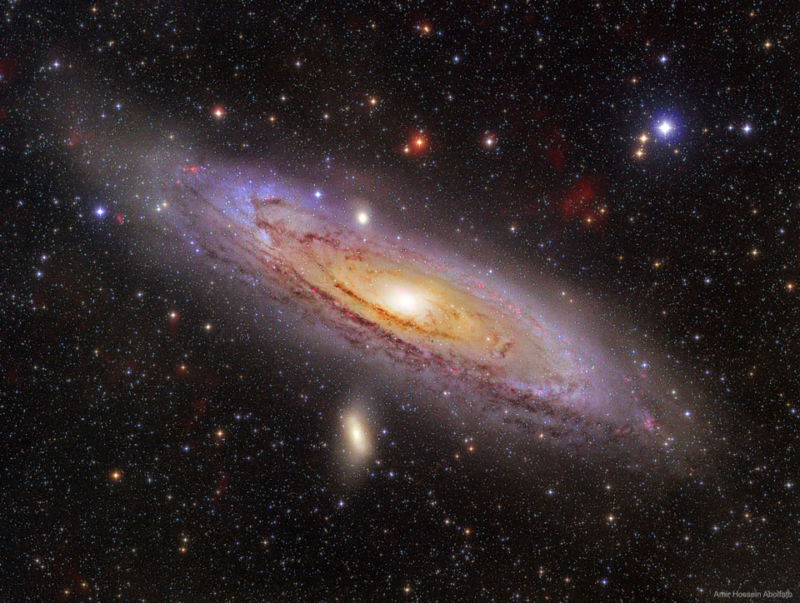
The large galaxies present in the current Universe weren’t always so big. Evidence indicates that they were built up over time, largely by collisions with other galaxies. These collisions have left marks that we can still detect: streams of stars that were drawn in from the victims of the collisions, and faint dwarf galaxies that still orbit the larger object that devoured many of their stars. With enough data, it’s possible to become a galactic historian and reconstruct the events that brought the modern-day giants to their present form.
Uncovering some of that history was the goal of a large, multinational collaboration, spelled out clearly in its name: the Pan-Andromeda Archaeological Survey. In a paper published on Wednesday in Nature, the team describes uncovering some of our nearest galactic neighbor’s violent past. The paper shows that Andromeda was built in part by two major collisions that have left clusters of stars occupying two perpendicular orbits. In the process of writing their paper, the researchers also uncover a bit of a mystery about an unexpected alignment between some of these clusters and Andromeda’s satellite galaxies.
Thinking global
The new work focuses on what are called globular clusters, which are large groups of stars held together by gravity. Unlike other stars—which shift position relative to each other as they orbit a galaxy’s center—the stars of a globular cluster stick together and orbit as a group. As a result, these gravitationally bound clusters of stars can survive the collisions between galaxies. That means they can be used as markers to retrace those collisions.
That’s exactly what the researchers behind the Pan-Andromeda Archaeological Survey decided to do. First, they eliminated the clusters near the core of Andromeda, since those clusters will have had their orbits shaped by more frequent interactions with other bodies there. Then, the researchers identified 92 globular clusters in the halo of the galaxy, orbiting at least 25,000 parsecs from its core. These were imaged to determine their motion relative to Earth using the Doppler shift. That information could be converted to the clusters’ local motion relative to the rest of Andromeda.
The analysis indicated there were two distinct populations. One group of clusters was associated with previously identified structures within Andromeda during its orbits. A second group, orbiting in a plane that’s 90° off from this one, doesn’t appear to be associated with anything in the galaxy itself. Notably, neither of these planes match that of Andromeda’s disk.
So what’s going on here? The structures within Andromeda provide a hint. With the exception of major features like spiral arms, structures like the ones here will average out into the background over time, as their component stars and other material are not gravitationally bound to each other. Thus, structures like the ones here have to be a product of a relatively recent event—an event like a galaxy merger. “These clearly represent debris from one or more accretions that must have occurred relatively recently,” the authors write, “in order for the underlying structures to be still coherent.”
This, they suggest, may be related to a merger with a relatively large galaxy that occurred about a billion years ago (“recent” means something different in astronomy.)
Old and odd
This obviously implies that the second group is much older and came from the earlier mergers that built Andromeda. Since the mass of globular clusters tends to be a constant fraction of the total galactic mass, the authors were able to make an estimate of the mass of the galaxy that was swallowed by Andromeda. That analysis suggests that Andromeda swallowed a galaxy that was well over 10% of its own mass at a time when it was much smaller than it is at present.
But there was something weird about that particular result. The orbit of the older group of globular clusters roughly lined up with the orbits of many of Andromeda’s satellite galaxies. That makes sense if we assume these globular clusters were stripped from some of the satellites. But it makes less sense when you consider that the satellites shouldn’t stay in the same plane for long, as gravitational interactions among themselves and with Andromeda’s dark matter halo should skew them out of the plane they started in.
The authors are at a loss to explain this part of their results. It’s possible that there was a preferred merger orientation that persisted for billions of years during Andromeda’s history. Or it’s possible there’s some additional effect influencing the orbits of the satellite galaxies or the globular clusters. But, at the moment, there’s simply nothing obvious to explain this alignment.
Which goes to show that archeology turns up interesting mysteries even when you dig into the past of an entire galaxy.
Nature, 2019. DOI: 10.1038/s41586-019-1597-1 (About DOIs).
source https://cvrnewsdirect.com/building-andromeda-galaxy-ended-up-with-stars-orbiting-at-right-angles/
No comments:
Post a Comment